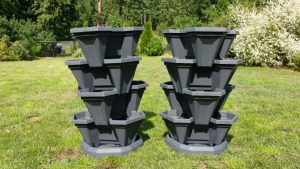Growing numbers of people are now becoming convinced of the importance of eating locally-grown food. After all, most of the world’s populations live in cities. So it is no coincidence that interest in urban gardening is growing in popularity.
In cities around the world, people are becoming enamored with the idea that they can grow their own food, increase their food security and reduce the mileage their food is must travel before reaching their plates.
This renewed interest in growing food stems from inequities and lack of access to fresh fruits and vegetables. These disparities impact communities of color, causing health comorbidities that create other health challenges. As communities, we must pull together to provide access to nutrition.
However, urban gardeners face three distinct challenges:
- Growing space is limited.
- Water supplies are not always ideal or readily available.
- Soil can easily be contaminated by industrial pollutants or neighbors’ carelessness.
How to Overcome Urban Gardening Challenges
If you’re interested in growing your own urban garden, here are 6 ideas to help you overcome these challenges:
1. Master the Use of Vertical Gardening Techniques
If you think a garden involves sprawling rows of produce separated by vast expanses of bare earth, then it’s time to rethink all that. Because in an urban environment, every inch of growing space counts.
For instance, you can use vertical growing techniques to maximize space in your garden. Many crops such as pole beans, squash, peas, melons, and cucumbers grow well vertically. You can build trellises and use vertical space to take advantage of this space-saving opportunity.
2. Conserve Water With a Drip Irrigation System
The Israelis are master urban gardeners. They’ve perfected the art of making the desert come alive with edible vegetation. They developed techniques so effective that drought-stricken nations call on them for guidance on how to implement similar systems.
And the drip irrigation system is their top tool for making that happen.
But whether you live in the desert or not, it’s a system worth mastering. So if you want to grow a lot of food in a cost-effective way, drip irrigation is a helpful technique that saves water and money in the process.
3. Avoid Watering Your Crops With Chemically-treated City Water
Agricultural expert Charles H. Wilber recommends avoiding the use of chemically-treated city water on food crops. In his book, How to Grow World Record Tomatoes, he explains that chemicals in the water are designed to kill harmful microorganisms. But they also kill the good microorganisms in your soil. You need these microorganisms for your food crops to be healthy. Watering with city water will ruin your soil in the long term. You should avoid that at all costs.
If city water is your only option, there are a couple of solutions you should consider. The first is harvesting rainwater in a catchment barrel if it is legal to do so in your area. Note that many communities ban this practice, as they want rainwater to drain into the water table. Check with your local zoning office for guidance.
The second means is using a filtration system for the city water that’s available to you.
4. Prioritize Crops That Can Handle Some Crowding
Some crops get stressed at the first signs of overcrowding. Then there are crops that will bear productively even if you plant them a bit too close together.
For example, you can plant pole beans almost on top of each other without sacrificing much in the way of productivity.
5. Familiarize Yourself With Crop Varieties That Will Grow Well in Containers
There are many shallow-rooted crops such as herbs, blueberries, and strawberries that can flourish in containers. Planting these can maximize your growing space significantly. For example, you can place pots filled with food crops and herbs on kitchen countertops, in window boxes, and on porches. This solution is also ideal for helping your plants to avoid soil contamination from neighboring sources.

6. Prioritize Crops With Quick Planting-to-Harvest Turnaround Times
There are radish, lettuce, and pak choi varieties that are ready for harvesting within about a month of germination. Plant these instead of vegetable varieties that take two to three months to mature. As a result, you’ll be able to harvest double to triple the volume of food from the same amount of growing space.
The Bottom Line: Tackling the Challenges of Urban Gardening Can Feed Many
Many families go without adequate nutrition in inner-city environments. Some of our most densely packed communities are food deserts, with residents lacking access to healthy foods. But when we teach members of our communities how to build community gardens, we create a pathway to correct these inequities.
These six suggestions will give you workable ideas for overcoming the most common challenges presented to gardeners who want to grow food crops in an urban gardening environment. Implementing these suggestions will help you succeed at growing food even if you have very little garden space.



